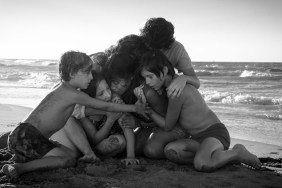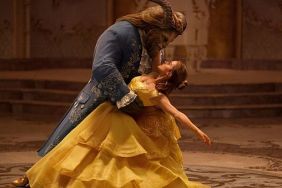While the nominees (and perceived snubs) in acting and directing will get the most digital ink in Academy Awards coverage, we at CraveOnline would like your attention for some of the “smaller” categories. Funny enough, our selected categories to comb through have had the most rule changes, the most committees, and nowadays, the most tweets of “who was that dude with the hair?” and “who was that homeless girl?”
The Other Oscars: Seventh Category: Best Production Design
To folks who’ve followed the Oscars for a long time, Best Achievement in Production Design might sound like a new award.
Indeed it was awarded for the first time last year, to Lincoln.
However the award has been around since 1927. This Oscar has had a few different names, but that’s because the history of titles within the art department were in flux, until seemingly standardized in the 1980s.
For the first 20 years of this award it was awarded as Best Interior Decoration. Then it shifted to Best Achievement in Art Direction-Set Decoration. Then the award plate just said Best Achievement in Art Direction.
However, from 1984 onward this film never went to an individual credited as the Art Director (and only occasionally did the Oscar go to art directors since the 1960s). So it had become a little odd that the Oscars had a category that directly names an actual art department position, yet the award went to other individuals: production designers and set decorators.
This award has a history similar to Best Cinematography. It used to bestow an award for a film shot both in color and in black and white for 26 years. And – like cinematography voters have struggled of late to measure how visual effects play into this category – this award has recently been given to effects driven films like Avatar, and Alice in Wonderland. But for this entry into “The Other Oscars” we’re going to focus on semantics.
Now that the award accurately describes who they award in this category, CraveOnline will give you just a little information on what all these art department titles mean.

Disclaimer: when I moved to Los Angeles, I kinda fell into art departments and didn’t know how the hierarchy worked. After wrapping the first film that I had worked on – the CraveOnline-deemed “minor classic” Excision – the art department hovered over a piece of paper that we’d deliver to the producers about what each of our credits should be. We had a first time production designer, who was known for his Theremin-playing and eccentricities. But what were the rest of us?
The longest tenured member of the crew – and also the one who slept the least, answered all director inquiries – became Art Director. He said to me, “you should be art department coordinator – that’s a real credit.” Okay. So that’s what I was. I got a “real credit.” It took a few more films and sets to truly get what all these people were in the longer credits of larger films. I just always knew that Production Designer was at the top. The Excision art director, Robert Platzer, informed me, jokingly, “well neither of us are eligible for an Oscar on this one.” The trophy was still named Best Achievement in Art Direction at the time.
Although I wasn’t exactly working on Gone With the Wind (but I agree with CraveOnline’s Witney Seibold, there is a nice shift to mother-daughter drama within Excision), how we came up with titles on the spot isn’t that much different than how “production designer” came to be.
It was in 1939 that the production designer title was coined by mega-producer David O. Selznick. Previous to this year, most designers were credited as an art director or interior decorator. Selznick bestowed it upon William Cameron Menzies for Gone With the Wind.
Gone With the Wind had an odd history of a film shoot. There is only one credited director – Victor Fleming – but two other directors worked on the film. George Cukor, who was fired, and Sam Wood, who replaced Fleming for three weeks while Fleming recovered from exhaustion (he had also filmed most of MGM’s The Wizard of Oz).
Selznick had more faith in Menzies than he did in his directors, famously sending out a memo that read “Menzies has the final word.”

“Production Designer,” as a term, reflected this. The vision he was trying to achieve was the producer’s. It was Menzies who created physical representations of Selznick’s commissioned drawings and paintings for the visual styles that he had hired and fired directors to follow.
Funny enough, his new credit did not give Menzies a Best Achievement in Art Direction-Set Decoration Academy Award: that went to the art director, Lyle Wheeler. Menzie got a special honorary Oscar for “outstanding achievement in the use of color for the enhancement of dramatic mood in the production of Gone with the Wind.” Menzies even shot the burning of Atlanta scene in Gone With the Wind. Obviously, the amounts of trust given to Menzies under his “production designed by” credit made this credit a much loftier one than “art direction.”
After the term’s inception for Menzies, most credits were given out as Art Director again.
What production designer has always meant, and art director used to mean if a production designer credit was not given, is: the head of the art department. The person who works with the director and cinematographer to create a certain visual aesthetic via constructed (or dressed) sets, props and locations.
The individuals who work the closest with the production designer, and who are also awarded in this category, are the set decorators. Set decorators shop for (or rent from property houses) all the decorative items including furniture, light fixtures and small items; they must also coordinate all handheld props with the property master.
The production designer will also focus on creating and approving designs for construction, models, vehicles, etc and maintaining a visual aesthetic with the costume designers.
So what does the current form of art director do?
The art director oversees everyone’s tasks and budgets on the set construction team (including builders, landscapers, prop makers, drapery departments, etc) and are often the go-to liaison between art and locations, visual effects and the costume department.
Essentially, although used sparingly as a title until the 1960s, production designer was always the more prestigious term and often used moreso on prestigious pictures.
I don’t know if there was some art department caucus in 1984 but since then, in Academy Award history, the recipients of this award have all been production designers and set decorators; and although the terms “art director” and “production designer” used to be used interchangeably, the defined hierarchy has been set and it is now awarded strictly only to those credited camps.
Like other awards scenarios, it took the bald dude a long time to catch up.
So the Best Achievement in Production Design nominees (Year Two) are:
12 Years a Slave

Production Designer: Adam Stockhausen; Set Decorator: Alice Baker
Stockhausen has designed the last two massive adult dollhouses for Wes Anderson (Moonrise Kingdom and the forthcoming Grand Budapest Hotel). In between the two Anderson storybooks was the gritty, raw 12 Years a Slave, which, he told Below the Line, was “more of a location-based film.”
The entire film was shot in Louisiana, which required not only old plantation locations and vistas, but also to some New England sensibilities to trick the upstate New York scenes into the southern shoot.
American Hustle

Production Designer: Judy Becker; Set Decorator: Heather Loeffler
Becker Domaine Home that she wanted to mash-up a cleaner, shinier looking 70s New York that she saw in Martin Scorsese’s King of Comedy with the appearance of the end of the Brutalist architecture movement: modular and concrete.
The result is very similar to the characters themselves: Becker and Loeffler used golden flourishes to try to hide a structurally square shape. A gilded comb-over.
Gravity

Production Designer: Andy Nicholson; Set Decorators: Rosie Goodwin and Joanne Woollard
There were only two physical sets created for Gravity – the interiors of the Russian and Chinese space capsules – but those sets were expanded into multiples due to camera movements.
If you’ve seen Gravity, that camera moves around a lot (and if you haven’t seen Gravity, see it! that camera moves around a lot!). The physical sets needed to not only best represent the space stations (and their respective nations inside), but also the highly choreographed movements inside.
The Great Gatsby

Production Designer: Catherine Martin; Set Decorator: Beverly Dunn
Martin is the only previous Oscar winner in this year’s category. In fact Gravity’s set decorator Joanne Woollard is the only other individual outside of Martin who’s been nominated before. Martin previously won two Oscars for Moulin Rouge! (one for Art Direction – see why they had to change the award name? – and another for Costume Design).
Martin is a dual nominee again this year for The Great Gatsby. With the emphasis that husband Baz Luhrmann has put on the visuals in his film, and Martin’s contributions to everything the camera enhances almost makes her a co-author.
Production Design is largely creating a physical world, and, whether you like him or not, Luhrmann’s physical world is unmistakable.
Martin told the Los Angeles Times that when she was picking out the wallpaper for Myrtle’s (Isla Fisher) apartment that “[it] was hard to describe to Baz, but when he saw the fabric and wallpaper, he said, ‘I’m totally on board.’”
We think that’s been a consistent reaction in their collaboration.
Her

Production Designer: K.K. Barrett; Set Decorator: Gene Serdena
Her is set in the future, but it doesn’t call attention to that with any flying billboards or extravagancies that this category usually likes to highlight. Let me take a cue from that last word: what Barrett does very well in Her is highlights.
His team used various specific plexiglass gel plates that, when the sun shone through, would give the office spaces and apartments an ever-present glowing hue. It’s a familiar glow for those who always have their laptop open, except by using different colors, Barrett makes it feel calmer.
However, although gorgeously subtle, Barrett’s nomination was probably helped by fusing the Los Angeles and Shanghai skylines into one city backdrop and providing the realization of the Subway to the Sea. The Academy largely lives in LA, and this is a more hopeful future vision than Elysium or Blade Runner.
Slideshow: 10 of the Best “Best Art Direction/Production Design” Winners
Brian Formo is a featured contributor on the CraveOnline Film Channel. You can follow him on Twitter at @BrianEmilFormo.
10 of the Best 'Best Production Design' Oscar Winners
-
Ben-Hur (1959)

This was the largest set ever built at the time. It took a thousand men more than a year’s work in a rock quarry to chip out enough rock for the arena. Winners William Horning and Edward Carfango also got to use some sets they oversaw the building of for Quo Vadis, a film for which they lost on a previous nomination, but they won here.
-
Fantastic Voyage (1966)

The only design award given for creating a large-scale brain, heart and arteries for spaceships (and Raquel Welch’s spacesuit) to traverse.
-
Star Wars (1977)

I’m a fan of set-building more than world-building. Here George Lucas oversaw both. From a design standpoint a great contribution was Lucas’ idea to create a “used universe.” He focused on dirty buildings in the future, instead of the sleek perfections that most sci-fi films had created.
-
Raiders of the Lost Ark (1981)

Steven Spielberg was so impressed by Norman Reynolds' fiberglass boulder that he decided to let it roll another 50 feet. It’s a good thing that most of the crew had already worked on the Star Wars films. Indiana Jones’ globetrotting was minor compared to those (though still distinct).
-
Amadeus (1984)

Technically, Patrizia von Brandenstein is the first female production designer to win this award. However, that’s more due to the semantics spoken about in the article. Anna Asp won the award the previous year for Ingmar Bergman’s Fanny and Alexander, but she was credited as an Art Director.
-
Dangerous Liaisons (1989)

There are a lot of ornate, old world winners in the history of this category. I chose Dangerous Liaisons because the private and public arenas are designed so differently. Both regal realms are presented as conquerable, but the public arena is more refined, and the private, so much dirtier.
-
Dick Tracy (1990)

There are far showier comic book movies, but if Warren Beatty gets one thing right in Dick Tracy it’s the comic strip panel look of this film. Outlined squares, empty diner booths and shoulder pads… Production Designer Richard Sylbert was instructed to only use the seven colors that could be achieved by newsprint.
-
Titanic (1997)

Well, when you rebuild (to a smaller scale, of course) the most expensive and elegant ship of all time, awards float your boat. Ben-Hur and Titanic were the most expensive set constructions of their respective times and they both won 11 Oscars.
It wasn’t just that nude drawing of Kate Winslet that was made by hand: every prop used in Titanic was made for the film.
-
Moulin Rouge! (2001)

Catherine Martin is the only crewmember to win two different technical awards for the same film: production design and costume design. Excuse the cheesy pun, but as this film walks the right side of the line of cheesy, Martin really makes Moulin Rouge! sing.
-
The Curious Case of Benjamin Button (2008)

Not only did designer Donald Graham Burt have to design for opposing eras and regions of the south ranging from backwoods evangelicalism to former plantations to urban ballrooms, but he also took to the air and into the sea in multiple time periods.
In a lot of ways, Benjamin Button is the more fantastical cousin of Forrest Gump, and so in a lot of ways, Burt provides that fantasy escape sheen across multiple generations and methods of living.








